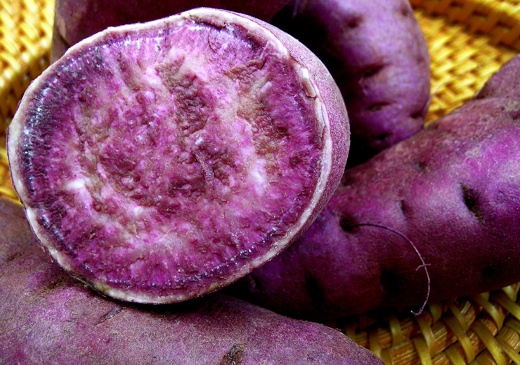SUBHEAD: Hawaiian soils reveal clues to cultural history
By Staff on 19 April 2005 in of Science Daily -
http://www.sciencedaily.com

Image above: Molokai sweet potatoes that grow in Hawaii. From (http://fineartamerica.com/featured/molokai-purple-sweet-potatoes-james-temple.html).By Staff on 19 April 2005 in of Science Daily -
http://www.sciencedaily.com

Oliver Chadwick is a doctor of dirt. The soil scientist—or biogeochemist, as he is known in some circles—is helping to shed light on the historical interactions between people and their soils in Hawaii. Chadwick, a professor of geography and environmental science at UC Santa Barbara, has been sponsored in this research by a special National Science Foundation program, "biocomplexity in the environment," linking the social sciences and the natural sciences. The results of his work have been published in two major scientific journals in the past year.
One of the world leaders in relating soils to ecology and earth system science, Chadwick belongs to a prominent research group in ecosystem studies at UCSB. His research utilizes Hawaii as a model ecosystem to understand changes in the sources of nutrients to rainforests.
Chadwick explains that Hawaii is also an ideal place to study the interaction of humans and the biosphere because it serves as a natural laboratory since it is enclosed and isolated, and because humans arrived there relatively recently, perhaps around 1200 years ago. For these studies, Chadwick and his team—which includes ecologists from Stanford University and the University of Wisconsin—joined with archaeologists at UC Berkeley and the University of Hawaii.
Together they discovered that the emergence of warriors, priests and rulers in Hawaii before the Europeans arrived in 1778 ultimately depended upon the quality of soil available for cultivation. Studies of soil and the history of agriculture in Hawaii tell the story of a human dependence on environmental processes. Chadwick's recent journal articles describe the work in detail.
"Environment, Agriculture, and Settlement Patterns in a Marginal Polynesian Landscape," co-authored with soil scientists and archaeologists and published in the Proceedings of the National Academies of Science (PNAS), recounts the study of more than 3,000 archaeological features on the southern flank of Haleakala Volcano in Maui, Hawaii, a wedge-shaped area called Kahikinui.
"Hawaii offers an exemplary opportunity to investigate the environmental constraints on human settlement patterns in an intensive agrarian economy, because of both its rich archaeological and ethnographic records, and its usefulness for understanding ecosystem development in an environmental context," wrote the authors.
Beginning at approximately 1400 A.D., Polynesian farmers established permanent settlements in Kahikinui based on dryland agriculture with sweet potato as the main crop. These settlements were ultimately devastated by disease after the arrival of Captain Cook in 1778. "Geological and environmental factors are the most important influence on Polynesian farming and settlement practices in an agriculturally marginal landscape," according to the authors.
The Polynesians had to cope with differences in soil quality due to variability in lava flows ranging in age from 3,000 to 226,000 years. It is more difficult to grow crops on the younger, rockier lava flows. There is patchiness in soil quality due to the way that lava misses places as it flows.
Additionally, the high rainfall at higher elevations washes out essential soil nutrients while lower elevations do not get enough rain to grow crops. "In short, indigenous Hawaiian cultivators identified and adapted their agricultural system to an optimal zone for sweet potato cropping within a landscape that was on the marginal limits for tropical root production," wrote the authors. "As subsistence increases, society can produce surplus and afford to have different classes including warriors, priests and rulers," said Chadwick.
"The basis of the hierarchy of groups or classes is the ability to produce a surplus of basic foodstuffs." However, it isn't clear whether the warrior class drove peasants to produce in agriculturally marginal areas, or if the class system developed out of surplus agriculture, he explained. And it is hard to determine what led people to move into marginal areas. It could have been a desire to get out from under an oppressive ruler, or they may have been sent there by the ruler.
Another article, "Soils, Agriculture, and Society in Precontact Hawaii," published in the journal Science, describes the analysis of intensive dryland field system of Kohala. Kohala, located on the northern end of the island of Hawaii, was first farmed around 1200 to 1300 A.D. with the most intensive farming between 1400 to 1800 A.D. "In Kohala we found evidence that the Hawaiians discovered a naturally augmented area of nutrients that had enough rain, a 'sweet spot' with a perfect matching of natural processes to human need," said Chadwick.
One question of interest is whether or not the Hawiians used this land sustainably, or if they depeleted the nutrients over time. To try to find out, the researchers sampled the open field as well as the soil underneath stone walls remaining from that period. "The nutrient status in the field was much less than that under the walls," said Chadwick. "They were depleting the soil; it's the usual result of farming."
The researchers believe that the losses continued over time even with augmentation of the sweet spot. They conclude that the Hawaiians used dryland agriculture on the younger islands of Maui and Hawaii because they could, because they found naturally enriched zones. Since they could not use the depleted soil on the older islands to support the same intensive dryland agriculture, they turned instead to dependence on irrigated valley agriculture.
See also:
Island Breath: Clues to Hawaiian chiefdoms 8/6/08
No comments :
Post a Comment